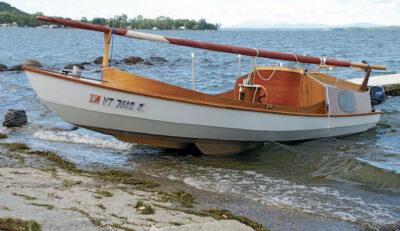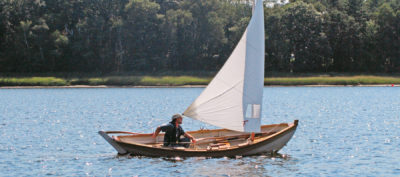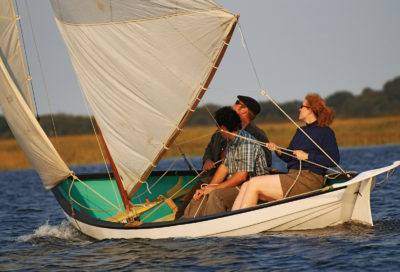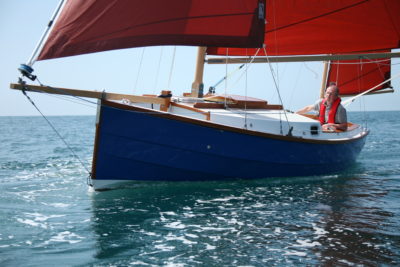 Shell Boats
Shell BoatsThe Schooner 18 is an iconoclastic camp-cruiser from Shell Boats of St. Albans, Vermont. Her aft cabin offers several advantages over the more typical forward-placed cabin—including good forward visibility. This arrangement, however, requires remote steering in the form of a pedestal-mounted wheel.
BIG SWIFTY is an 18′ schooner from Shell Boats of St. Albans, Vermont. Her design is called the Schooner 18, and is the largest in proprietor Fred Shell’s Swifty line, whose basic hull form and techniques range from the 7′ Leif up to the boat featured here. The evolution of these boats has coursed over the past 25 or so years, and was inspired by a synthesis of Dutch and Norwegian hull forms and construction methods, as well as the Joel White-designed Nutshell pram. The Swifty moniker was given in honor of a legendary musician, whose identity we’ll return to after considering some of this boat’s attributes.
Fred Shell sails more than any builder I know. He’s the first on the lake in the spring, and the last off in the fall. He copes with the hard-water season on Lake Champlain by tinkering with iceboats. Since, like most of us, he doesn’t live on the waterfront, feeding his habit requires boats that are easily trailered, launched, and rigged. Fred fills these needs by designing and building a variety of imaginative designs, making them available as kits or finished boats. Shell boats’ hallmarks are low cost, simple construction, economical materials, light weight, and good performance.
For the moment, let’s leave aside the fact that Fred’s Schooner 18, with its aft-placed cabin, appears to be sailing backwards, and contemplate the hull and its construction. The basics are these: The boat has a flat 3⁄8″ plywood bottom and ¼″ lapstrake topsides. The chine seam is fiberglass-taped and the laps are epoxy-glued. Rather than complicate life with a centerboard and trunk, Shell has fitted the Schooner 18 with bilge keels and a skeg. These appendages provide lateral resistance, and metal shoes mounted on these “feet” allow the boat to beach and trailer with alacrity, as she perches in a solid, three-point stance. This configuration also protects the lightweight bottom of the boat and eliminates the need, weight, and cost of fiberglass sheathing.
 Shell Boats
Shell BoatsFor trailering and storage, the Schooner 18’s rig stows in a crutch forward and on permanent gallows on the cabintop.
The cockpit sole is a false bottom, incorporating three flotation chambers. The splash-well structure aft for the motor and tank includes flotation as well. The stem is a stitch-and-glue technique epoxy fillet, strong and simple. The 5⁄8″ plywood decks are simply butted to the sheer, with the joint backed by an epoxy fillet after gluing and screwing it. The dramatic raked coaming stiffens the deck structure while keeping the cockpit dry. The low, short cabin is built with simple joinery, primarily of lightweight plywood, with a few stringers and beams here and there.
The deck arrangement is well worth our contemplation. The Schooner 18’s appearance strikes me as Venetian, or maybe even Venutian, but after a spirited Saturday morning sail I will heartily endorse the concepts embodied in this aft-cabin, forward-cockpit layout. It’s an iconoclastic concept to a contemporary American eye, though we’ll find it on traditional Norwegian rowing and sailboats. It works well: sailing visibility is completely unencumbered. The outboard motor and gas tank are screened from noise and view by the cabin. The bridge deck offers majestic seating for a crew of two, especially when equipped with folding cushions. The huge padded cockpit bay offers copious sprawling and lounging space, cleverly made more gracious by a footwell and the raked coaming. One can sit comfortably almost anywhere, as dictated by trim or social needs.
“BIG SWIFTY sails very well. She is quick to handle and accelerate, with a nice turn of speed for such a small boat.”
One of the idiosyncrasies necessitated by the Schooner 18’s aft cabin is remote steering. Rather than invoking Rube Goldberg, Shell has addressed this challenge with a simple, well-executed scheme. He has mounted an off-the-shelf cable helm unit in a combination mast partner–steering pedestal. This puts the 10″ wooden wheel within easy reach of the bridge deck seats, and also of a skipper sitting one notch forward and outboard as necessary.
The helm is coupled to a skeg-mounted rudder with a tiller arm sized to give one turn of the wheel, stop to stop. The resulting steering is easy, quick, and positive. There is no “feedback” as with a tiller, and that can leave experienced small-boat sailors feeling a bit empty, but I found it very manageable and felt comfortable at the helm within minutes. The overriding triumph is the space saving afforded by the helm. Tillers, of whatever configuration, restrict the use of space within their arc and thus they dominate many small boats.
The Schooner 18’s rig is just about as simple as could be hoped for. One hundred eighteen square feet of sail are almost evenly divided between sprit-boomed, leg-o’-mutton fore and main. The sails are luff-sleeved and live on their tapered spruce masts. The foresail is trimmed by a single sheet running to a swivel cam cleat mounted on the steering pedestal.
The main has a double sheet run to cam cleats on either side of the companionway, leaving the hatch free, and puts the sheet within the helmsman’s reach on either tack. The rotating masts, set in tubes with plastic bushings, allow roller furling or reefing when needed. When the sails are reefed, one simply strikes the sprit-booms as the reduced sails are small enough to set well without them. The rig stows and trailers in a crutch forward and on a gallows on the aft cabin top. This wide, arcing gallows allows the spars to be set to either side to free the companionway for traffic.
The cabin offers lounging headroom, a 6′ 6″ flat, and many convenient nooks, shelves, and cubbies. The very compact space is made habitable by large deadlights along the cabin sides, a full-width sliding hatch aft, and the very generously proportioned companionway. Any number of screen and canopy schemes could enhance the cruising comforts for one or two.
 Shell Boats
Shell BoatsThe Schooner 18 carries 50 sq ft in her foresail, and 68 sq ft in her main. Sleeved luffs and sprit booms make setup and reefing as simple as can be.
The Schooner 18 is definitely not for the classicists among us. But the sailors among us must take note. The Schooner 18 sails very well. She is quick to handle and accelerate, with a nice turn of speed for such a small boat. She is stiff and dry, and reasonably rigged in terms of sail area, requiring the crew to trim the boat, but no heroic hiking is involved. The boat is light enough to be easily managed under oars, which, by the way, stow either forward under the side decks or in their sockets with blades cleated to the cabin sides in a sort of ready position.
This boat’s unusual configuration lends itself readily to the use of an outboard auxiliary. Indeed, it is a far happier auxiliary than most boats its size. Shell’s normal setup utilizes a 3.5-hp engine with an integral gas tank, a rig that provide hull speed—about 5 knots—and 12 miles of cruising on a tank of gas. A spare gas can stowed in the splash well extends the range by about 100 miles. On the day I sailed with him, Shell was experimenting with a 6-hp engine from another of his designs. He rigs the engines for semi-remote operation, extending the starter pull cord and the engine tilt cord over the cabin roof, and the shifter and twist-throttle handles forward through the cabin. Thus, once the engine is started, the helmsman steering with the wheel has engine controls within reach.
Shell Boats kits include sails, shaped spars, and all the plywood parts cut to shape and fit. The materials are basic and inexpensive, though always reasonable choices. Shell preassembles each kit, so that not only are hardware and screws included, but so are the pilot holes for the screws. He’ll include an optional epoxy kit if you so desire, and requires only that a customer pro-vide tools and consumables such as paint, sandpaper, brushes, and rags. He even builds his owns sails for the kits. His boats are not high-gloss, heavily detailed show-pieces. They are honest and useful, good performers with character. They are unmatched when judged by cost to usefulness. And, after all, any boat named for a Frank Zappa song must be way cool!![]()
Schooner 18 Particulars
Length: 18′ 0″
Beam: 6′ 2″
Draft: 11″
Sail area: 118 sq ft
 Shell Boats
Shell BoatsThe Schooner 18’s shape suggests simple construction. Twin bilge keels will allow the boat to sit bolt upright on the beach, and provide lateral stability. The boat is available in either finished or kit form.
For more information, contact Shell Boats LLC, 561 Polly Hubbard Rd., St. Albans, VT 05478; 802–524–9645.
Is there a boat you’d like to know more about? Have you built one that you think other Small Boats readers would enjoy? Please email us your suggestions.













Join The Conversation
We welcome your comments about this article. If you’d like to include a photo or a video with your comment, please email the file or link.